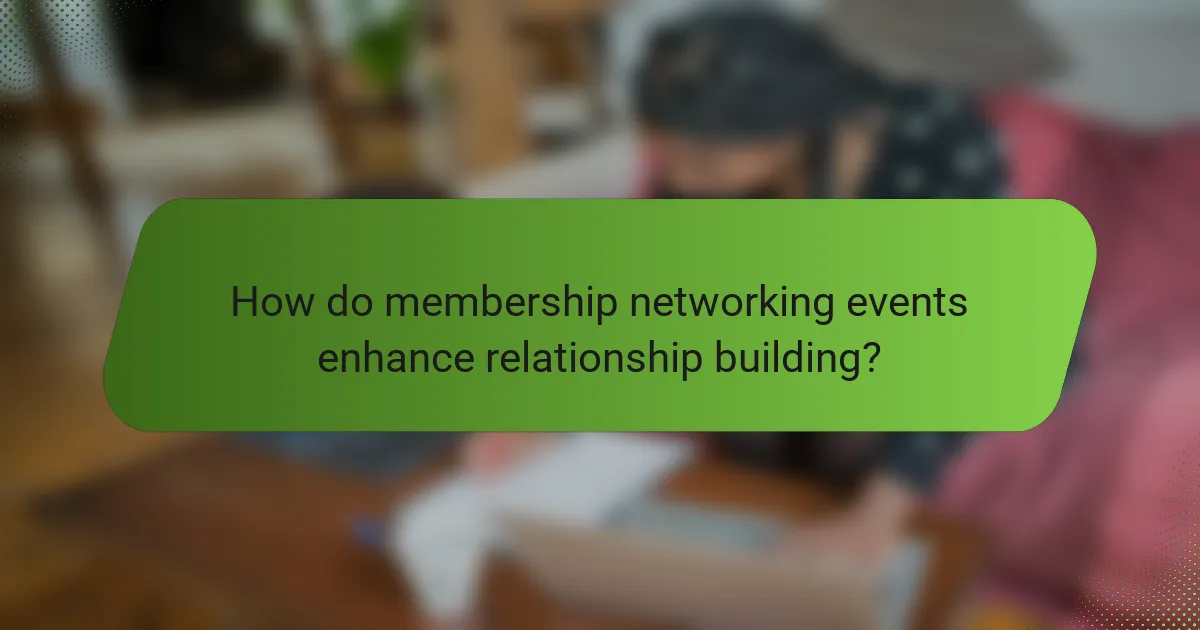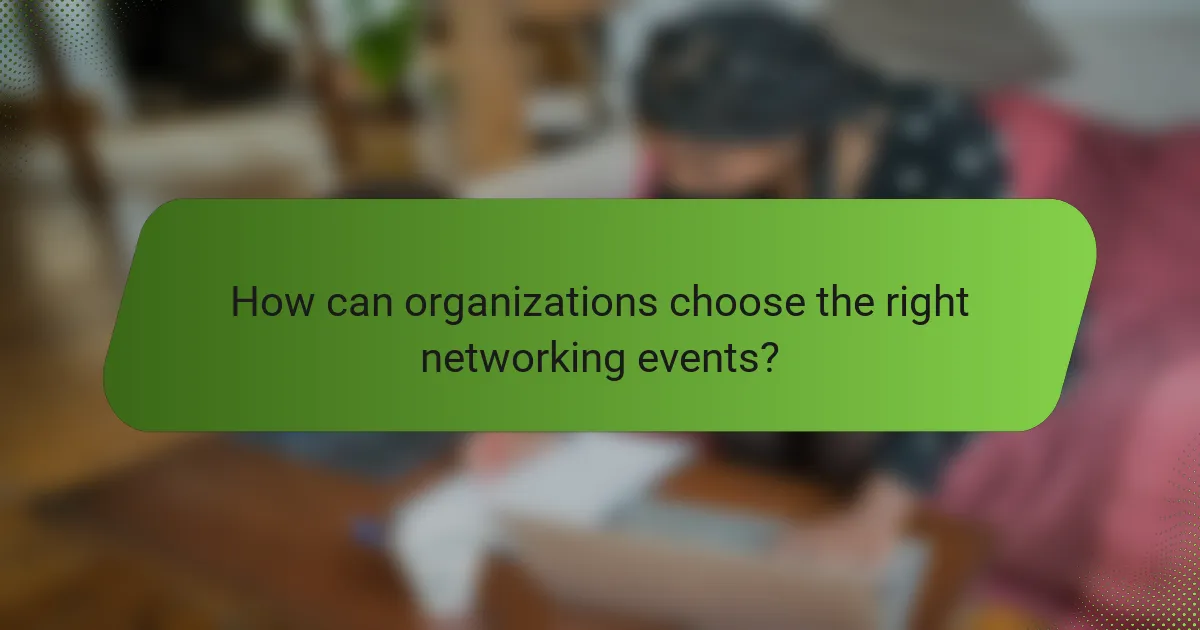Membership networking events play a crucial role in relationship building by offering structured opportunities for individuals to connect and collaborate. These gatherings not only foster trust among like-minded professionals but also enhance community engagement, leading to meaningful partnerships and a stronger sense of belonging within professional circles.

How do membership networking events enhance relationship building?
Membership networking events significantly enhance relationship building by providing structured opportunities for individuals to connect and collaborate. These events create an environment where participants can engage with like-minded professionals, fostering trust and rapport that can lead to meaningful partnerships.
Facilitated introductions
Facilitated introductions are a key feature of membership networking events, where organizers help participants meet others who share similar interests or goals. This can be done through icebreaker activities or by assigning mentors to newcomers, ensuring that everyone has the chance to connect with relevant individuals.
For example, during a networking event, attendees might be paired based on their industry or expertise, allowing for more targeted conversations. This approach not only saves time but also increases the likelihood of forming valuable connections.
Structured networking activities
Structured networking activities, such as roundtable discussions or speed networking sessions, encourage participants to engage with multiple people in a short amount of time. These formats promote interaction and help break down barriers, making it easier for attendees to initiate conversations.
Consider incorporating activities like “networking bingo,” where participants must find others who match specific criteria, or timed discussions that rotate participants every few minutes. These methods keep the energy high and ensure that everyone has the opportunity to meet a variety of contacts.
Follow-up engagement strategies
Follow-up engagement strategies are essential for maintaining the connections made during networking events. After the event, participants should reach out to their new contacts with personalized messages, referencing specific conversations to reinforce the relationship.
Utilizing platforms like LinkedIn for follow-ups can be effective, as it allows for ongoing communication and sharing of relevant content. Additionally, consider scheduling coffee chats or virtual meetings to deepen the connection and explore collaboration opportunities further.

What are the benefits of community engagement at networking events?
Community engagement at networking events fosters meaningful connections and enhances collaboration among participants. By actively participating, individuals can build relationships that lead to shared opportunities and a stronger sense of belonging within their professional circles.
Increased collaboration opportunities
Networking events create a platform for individuals to meet potential partners, collaborators, or mentors. Engaging with others can lead to joint projects, shared resources, and innovative ideas that may not have emerged in isolation.
To maximize collaboration, attendees should approach conversations with an open mind and a willingness to explore synergies. Consider following up with new contacts after the event to discuss potential collaborations in more detail.
Access to diverse perspectives
Community engagement allows participants to hear from a variety of voices and experiences, enriching their understanding of different viewpoints. This diversity can spark creativity and inspire new approaches to problem-solving.
To benefit from diverse perspectives, actively seek out conversations with individuals from different backgrounds or industries. This can help broaden your horizons and provide insights that may be applicable to your own work.
Strengthened local networks
Engaging with the local community at networking events helps to build robust relationships that can support both personal and professional growth. Strong local networks can provide resources, referrals, and support during challenging times.
To strengthen your local network, participate in community-focused events regularly and contribute to discussions. Consider joining local professional organizations or volunteering, as these activities can enhance your visibility and connections within the community.

How can organizations choose the right networking events?
Organizations can choose the right networking events by clearly defining their goals and understanding the needs of their target audience. This involves evaluating various event formats, accessibility, and potential for meaningful connections.
Identifying target audience
Understanding the target audience is crucial for selecting effective networking events. Organizations should consider demographics such as age, profession, and interests to ensure alignment with the event’s focus.
Surveys or informal discussions can help gauge the preferences of potential attendees. For instance, if the audience consists mainly of young professionals, events that feature interactive elements or technology may be more appealing.
Assessing event formats
Different event formats cater to varying networking styles and objectives. Organizations should evaluate whether they prefer formal conferences, casual meetups, workshops, or online webinars based on their goals.
For example, a workshop format allows for hands-on collaboration, while a conference may provide broader exposure to industry leaders. Consider the balance between structured activities and informal networking opportunities to maximize engagement.
Evaluating venue accessibility
Venue accessibility is a key factor in ensuring attendance and participation. Organizations should assess the location’s convenience, transportation options, and facilities for individuals with disabilities.
Choosing venues near public transport hubs or offering ample parking can significantly enhance accessibility. Additionally, considering local regulations regarding accessibility can help organizations comply with standards and create an inclusive environment.

What role do technology platforms play in networking events?
Technology platforms are essential for enhancing the efficiency and effectiveness of networking events. They facilitate organization, engagement, and communication, making it easier for participants to connect and collaborate.
Event management tools
Event management tools streamline the planning and execution of networking events by providing features like registration, ticketing, and scheduling. These platforms help organizers manage attendee lists, track RSVPs, and communicate important updates, ensuring a smooth experience for all participants.
Popular event management tools include platforms like Eventbrite and Cvent, which offer customizable options to suit various event sizes and types. When selecting a tool, consider factors such as user-friendliness, integration capabilities, and pricing structures, which can range from free to several hundred dollars depending on features.
Virtual networking solutions
Virtual networking solutions enable participants to connect remotely, making networking accessible regardless of geographical limitations. These platforms often include video conferencing, chat rooms, and breakout sessions, allowing for meaningful interactions among attendees.
Examples of effective virtual networking solutions include Zoom and Hopin, which offer features like virtual lobbies and networking lounges. When choosing a solution, prioritize ease of use and the ability to facilitate small group discussions, as these can significantly enhance engagement.
Social media integration
Social media integration is crucial for promoting networking events and fostering ongoing engagement. By leveraging platforms like LinkedIn, Facebook, and Twitter, organizers can reach a wider audience and encourage participants to share their experiences and connect with one another.
To effectively integrate social media, create event-specific hashtags and encourage attendees to post updates or photos. This not only boosts visibility but also helps build a sense of community among participants, enhancing the overall networking experience.

How can attendees maximize their networking experience?
Attendees can maximize their networking experience by being intentional and strategic in their approach. This involves setting clear objectives, preparing effective communication tools, and actively engaging with others during events.
Setting clear goals
Establishing clear goals is crucial for effective networking. Determine what you want to achieve, whether it’s meeting potential collaborators, finding mentors, or exploring job opportunities. Having specific objectives helps guide your interactions and keeps you focused.
Consider writing down your goals before the event. For instance, you might aim to connect with five new contacts or gather insights on a particular industry trend. This clarity will enhance your confidence and direction during conversations.
Preparing an elevator pitch
An elevator pitch is a brief, compelling introduction that summarizes who you are and what you do. Preparing a concise pitch, ideally lasting 30 seconds to one minute, allows you to communicate your value effectively when meeting new people.
Include key elements in your pitch, such as your name, current role, and a unique aspect of your work or interests. Practice delivering it smoothly to ensure you come across as confident and engaging. Tailor your pitch based on the audience to make it more relevant.
Engaging in active listening
Active listening is essential for building meaningful connections. It involves fully concentrating on the speaker, understanding their message, and responding thoughtfully. This approach fosters trust and encourages more in-depth conversations.
To practice active listening, maintain eye contact, nod in acknowledgment, and ask follow-up questions based on what the other person shares. Avoid interrupting and give them space to express their thoughts. This not only enhances your networking experience but also leaves a positive impression.
